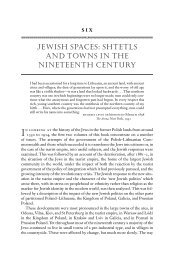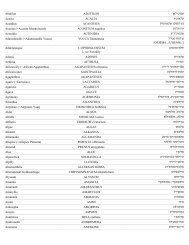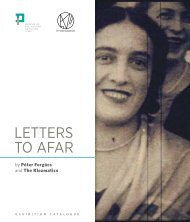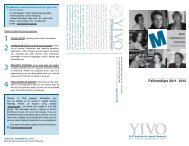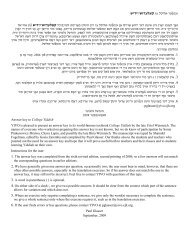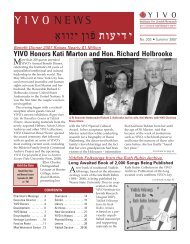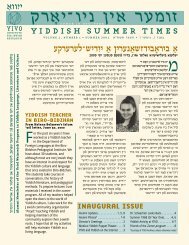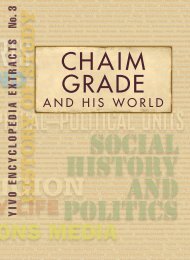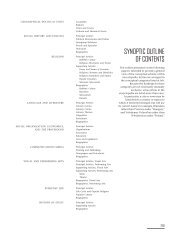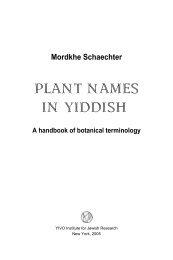You also want an ePaper? Increase the reach of your titles
YUMPU automatically turns print PDFs into web optimized ePapers that Google loves.
mas, musicals, romantic fantasies, farces,<br />
military films, and adventure films.<br />
Waszyáski survived the war in the Soviet<br />
Union, then settled in Italy where,<br />
among other activities, he assisted Orson<br />
Welles. His Variety obituary lists him as<br />
Prince Michael Waszynski.<br />
Weiss, Ji÷í (1913–2004), director and<br />
screenwriter. The son of a Jewish industrialist,<br />
Weiss was an established social<br />
documentarian when he left Prague for<br />
London in 1938; after World War II he<br />
became one of Czechoslovakia’s leading<br />
filmmakers. His 1959 Romeo, Julie a tma<br />
(Romeo, Juliet and Darkness), in which a<br />
Jewish girl is sheltered by a Czech schoolmate,<br />
was an international success. Weiss<br />
left Czechoslovakia in 1968 but returned<br />
in 1989 to film the quasi-autobiographical<br />
Martha und Ich (Martha and I).<br />
• Barbara Armatys, Leszek Armatys, and<br />
WiesËaw Stradomski, Historia filmu polskiego,<br />
vol. 2, 1930–1939 (Warsaw, 1988); WËadysËaw<br />
Banaszkiewicz and Witold Witczak, Historia<br />
filmu polskiego, vol. 1, 1895–1929 (Warsaw,<br />
1989); Boris Berest, History of the Ukrainian<br />
336 CIRCUMCISION<br />
<strong>Cinema</strong> (New York, 1962); John Cunningham,<br />
Hungarian <strong>Cinema</strong>: From Coffee House to Multiplex<br />
(London, 2004); Judith N. Goldberg,<br />
Laughter through Tears: The Yiddish <strong>Cinema</strong><br />
(Rutherford, N.J., 1983); Eric A. Goldman, Visions,<br />
Images, and Dreams: Yiddish Film Past<br />
and Present (Ann Arbor, 1983); Natan Gross,<br />
Toldot ha-kolno‘a ha-yehudi be-Polin, 1910–<br />
1950 (Jerusalem, 1989/90); Peter Hames, The<br />
Czechoslovak New Wave (Berkeley, 1985); Joshua<br />
Francis Hirsch, Afterimage: Film, Trauma,<br />
and the Holocaust (Philadelphia, 2004); J.<br />
Hoberman, Bridge of Light: Yiddish Film between<br />
Two Worlds (New York, 1991); Dina<br />
Iordanova, <strong>Cinema</strong> of the Other Europe: The Industry<br />
and Artistry of East Central European Film<br />
(London, 2003); Peter Kenez, <strong>Cinema</strong> and Soviet<br />
Society, 1917–1953 (Cambridge, 1992); Jay<br />
Leyda, Kino: A History of the Russian and Soviet<br />
Film (New York, 1960); Antonín J. Liehm,<br />
Closely Watched Films: The Czechoslovak Experience<br />
(White Plains, N.Y., 1974); Mira Liehm<br />
and Antonín J. Liehm, The Most Important Art:<br />
East European Film after 1945 (Berkeley, 1977);<br />
David Matis, “Tsu der geshikhte fun yidishn<br />
film,” IKUF-almanak (1961): 439–465; Boles-<br />
Ëaw MichaËek and Frank Turaj, The Modern<br />
<strong>Cinema</strong> of Poland (Bloomington, Ind., 1988);<br />
István Nemeskürty, Word and Image: History<br />
of the Hungarian <strong>Cinema</strong>, 2nd enl. ed. (Budapest,<br />
1974).<br />
—J. Hoberman<br />
CIRCUMCISION. Popular customs and<br />
practices regarding circumcision (Yid.,<br />
bris; Heb., berit milah) seem to have been<br />
fairly consistent within the East European<br />
Jewish community, both Hasidic and<br />
Misnagdic, although there were some regional<br />
variations as to details. Through<br />
out the days leading up to the bris, care<br />
was taken to prevent the demon Lilith<br />
from taking the child: schoolboys were<br />
brought to recite the Shema‘ prayer every<br />
night (for which they were rewarded with<br />
sweets), and amulets were placed in the<br />
room with the child. The night before the<br />
ceremony was to take place, a special vigil<br />
(vakhtnakht) was kept. Candles were lit<br />
throughout the house. After a special<br />
meal (se‘udah), the men present recited<br />
psalms and studied Torah until midnight.<br />
The ritual circumciser (mohel) who was to<br />
perform the ceremony would also be<br />
present and would sometimes leave his<br />
Rosh Hashanah card depicting a circumcision ceremony (Yid., bris; Heb., berit milah). The fruits on the “tree of life” are labeled (left to right), “luck,”<br />
“life,” and “joy,” and the Yiddish verse reads: “A child, boy is born / May he have happiness and live long! / A child, a joy, sugar-sweet / Today was his<br />
bris.” Published by Verlag Central, Warsaw. (YIVO)<br />
S<br />
R<br />
L



